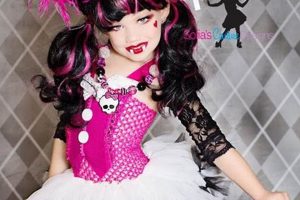Creating a homemade version of the recognizable green-clad plumber’s attire involves assembling easily sourced clothing items and accessories. This approach offers an alternative to purchasing pre-made outfits, often allowing for greater personalization and cost savings. For example, a simple rendition might include a green long-sleeved shirt, blue overalls, and a green hat adorned with the letter “L.”
The appeal of crafting a personalized version lies in the ability to tailor the fit, fabric, and details to individual preferences. This method often proves more budget-friendly, especially when utilizing existing wardrobe components. Furthermore, engaging in the creation process fosters a sense of accomplishment and originality, differentiating the result from mass-produced alternatives. The practice extends beyond mere replication, encouraging creative interpretation and unique embellishments.
The subsequent sections will provide specific guidance on sourcing appropriate materials, constructing key components such as the hat and overalls, and adding finishing touches to achieve a polished and recognizable result. Detailed instructions will be presented to facilitate the construction process for individuals with varying levels of crafting experience.
Essential Guidance for a Self-Made Luigi Attire
The following recommendations aim to optimize the creation process, ensuring a high-quality and recognizable result.
Tip 1: Accurate Color Matching: Prioritize selecting fabric and clothing items that closely match the characteristic green and blue hues associated with the character. Inconsistencies in color can detract from the overall authenticity.
Tip 2: Overalls Customization: If repurposing existing overalls, consider altering the length and fit to better resemble the character’s proportions. Adjusting the straps and leg openings can significantly enhance the visual accuracy.
Tip 3: Hat Construction Considerations: When constructing the hat, utilize a stiff interfacing material to maintain its shape and prevent it from collapsing. Precise measurements are crucial for ensuring a proper fit.
Tip 4: Meticulous “L” Emblem Placement: The placement of the “L” emblem on the hat should be centered and securely affixed. Utilize adhesive appropriate for the chosen fabric to prevent detachment during wear.
Tip 5: Attention to Detail: Accessories, such as white gloves and appropriately styled footwear, contribute significantly to the overall impression. Consider incorporating these elements for increased accuracy.
Tip 6: Proportionate Mustache Selection: If including a mustache, choose one that is appropriately sized and styled to complement the overall aesthetic. An ill-fitting or poorly styled mustache can negatively impact the appearance.
Tip 7: Durability Reinforcement: Reinforce seams and stress points, particularly on the overalls and hat, to enhance the durability of the attire. This is especially important for costumes intended for frequent wear.
Implementing these suggestions enhances the visual fidelity and structural integrity of the homemade attire. By focusing on color accuracy, proper fit, and attention to detail, individuals can achieve a superior outcome.
The subsequent section will explore common pitfalls to avoid during the creation process, further refining the approach and ensuring a successful result.
1. Green fabric selection
The selection of green fabric represents a foundational element in the creation of a convincing self-made Luigi costume. The specific shade, texture, and weight of the chosen material directly influence the overall visual impact and authenticity of the finished product.
- Hue Accuracy
The character Luigi is associated with a specific, recognizable shade of green. Deviations from this precise hue diminish the costume’s recognizability. For instance, selecting a lime green or forest green fabric will not accurately represent the character’s established color palette. A direct comparison to official imagery or color swatches is advisable to ensure fidelity.
- Material Texture and Sheen
The fabric’s texture and sheen contribute to the perceived quality of the costume. A highly reflective or overly textured material can appear artificial or distracting. Conversely, a dull or lifeless fabric may lack visual appeal. Cotton blends or similarly matte materials often provide a balance between authenticity and visual interest.
- Fabric Weight and Drape
The fabric’s weight affects how the costume drapes and fits. A lightweight fabric may appear flimsy or lack structure, while a heavy fabric can be uncomfortable to wear or create an unflattering silhouette. A medium-weight fabric, such as a twill or poplin, typically offers a suitable balance of durability and drape.
- Colorfastness and Washability
Practical considerations such as colorfastness and washability are essential for maintaining the costume’s appearance over time. A fabric that bleeds or fades easily will quickly degrade the costume’s visual appeal. Selecting a fabric that can be safely laundered contributes to the longevity and usability of the creation. Pre-washing the fabric is recommended to mitigate potential color bleed.
The careful selection of green fabric is thus a crucial step in constructing a successful and visually appealing Luigi costume. Attending to hue accuracy, material texture, fabric weight, and practical considerations significantly enhances the overall quality and impact of the finished product. Failure to consider these factors can result in a costume that lacks authenticity and visual appeal.
2. Overalls construction
Overalls construction forms an integral component within the broader scope of creating a self-made Luigi costume. The overalls, a defining garment associated with the character, necessitate careful planning and execution to achieve a recognizable and authentic representation. Deficiencies in overalls construction directly impact the overall effectiveness of the costume. For example, poorly fitted or inaccurately colored overalls detract significantly from the intended visual effect, undermining the recognizability of the character. Conversely, well-constructed overalls, adhering to accurate color palettes and proportional guidelines, enhance the costume’s fidelity.
The process of constructing overalls can encompass several approaches, ranging from adapting existing garments to creating them from scratch. Adapting existing overalls requires modifications such as altering the length, adjusting the straps, and ensuring proper fit. Creating overalls from scratch necessitates pattern drafting, fabric cutting, and sewing, demanding a higher level of skill and precision. Real-wor
ld examples of successful overalls construction demonstrate the importance of accurate measurements, durable stitching, and appropriate fabric selection. The choice of fabric weight and texture influences the garment’s drape and overall appearance, affecting its visual appeal. Reinforcing stress points and seams ensures durability, extending the costume’s lifespan.
In conclusion, overalls construction represents a critical determinant of the success of a self-made Luigi costume. Accurate design, meticulous execution, and careful attention to detail are essential. While challenges exist in achieving professional-level results, a deliberate and methodical approach can significantly enhance the outcome. The practical significance of understanding the nuances of overalls construction lies in the ability to create a costume that effectively captures the essence of the character, resulting in a visually compelling and recognizable representation.
3. Hat creation method
The hat is a critical identifying feature of a Luigi costume. The method employed in its creation directly impacts the overall recognizability and accuracy of the resulting homemade outfit. An inadequately constructed hat detracts significantly from the intended visual representation, diminishing the effectiveness of the entire effort. The choice of materials, the precision of measurements, and the adherence to established design parameters are all key factors influenced by the selected hat creation method. For example, a flimsy, poorly shaped hat constructed from inadequate materials renders the costume less authentic. Conversely, a well-formed, appropriately colored hat constructed using durable materials contributes significantly to the costume’s visual impact, enhancing its recognizability.
Different hat creation methods offer varying degrees of complexity and require different skill sets. Simplistic approaches may involve repurposing existing hats or utilizing pre-made patterns, while more advanced techniques entail creating a custom pattern and employing sewing or crafting skills to construct the hat from raw materials. The decision regarding which method to employ often hinges on the individual’s skill level, available resources, and desired level of accuracy. For instance, individuals with limited sewing experience may opt for a simpler method involving adapting an existing green cap, whereas those with more advanced skills might choose to construct a hat entirely from scratch using buckram, felt, and other materials. The integration of the “L” emblem, its placement, and the chosen method for its attachment also form a crucial aspect of the hat creation process. A poorly attached or misaligned emblem negatively impacts the hat’s appearance, while a securely affixed and accurately positioned emblem enhances the costume’s fidelity.
The practical significance of understanding the relationship between the hat creation method and the overall quality of a homemade Luigi costume lies in the ability to make informed decisions regarding materials, techniques, and level of effort. By carefully considering the factors outlined above, individuals can optimize the construction process and create a hat that contributes positively to the visual impact and recognizability of the costume. Challenges associated with hat creation, such as achieving a proper fit or maintaining the hat’s shape, can be mitigated through careful planning, precise measurements, and the use of appropriate materials and techniques. The hat creation method, therefore, is not merely a procedural step but a critical component that determines the overall success of the endeavor to create a believable and recognizable Luigi costume.
4. "L" emblem accuracy
Within the realm of self-made Luigi costumes, the accuracy of the “L” emblem serves as a critical determinant of overall recognizability. This single detail, prominently displayed on the character’s signature hat, functions as a visual keystone, directly influencing the audience’s perception of the costume’s authenticity. Deficiencies in emblem design or execution can undermine the entire endeavor, diminishing the costume’s impact.
- Font Fidelity
The “L” emblem utilizes a distinct font, characterized by specific serifs and stroke weights. Deviations from this established typeface, even subtle ones, can detract from the emblem’s visual integrity and reduce its immediate recognizability. For instance, employing a generic sans-serif font instead of a close approximation of the original typeface compromises authenticity. The use of readily available font identification tools and digital imaging software facilitates accurate replication.
- Proportional Correctness
The emblem’s dimensions, both in absolute terms and relative to the hat’s size, play a crucial role in its visual balance and accuracy. An oversized or undersized emblem appears disproportionate and disrupts the overall aesthetic harmony. Precise measurements, guided by reference images of the original character design, are essential for achieving proportional correctness. Considerations should include the emblem’s height, width, and the curvature of its form.
- Color Consistency
The emblem’s color must closely match the established white hue associated with the character’s design. Variations in color, such as off-white or cream, can diminish the emblem’s visual impact and suggest a lack of attention to detail. Utilizing color swatches or digital color pickers to identify and replicate the precise white tone ensures color consistency. The material of the emblem should also exhibit a smooth, even surface, free from discoloration or blemishes.
- Secure Attachment
The method employed for attaching the emblem to the hat must ensure its secure and permanent fixation. A poorly attached emblem, prone to detachment or misalignment, undermines the costume’s overall quality and durability. Employing adhesives appropriate for the hat’s fabric and the emblem’s material, or utilizing sewing techniques for more robust attachment, minimizes the risk of detachment. The emblem’s placement must be centered and aligned according to established design parameters.
These facets collectively underscore the importance of meticulous attention to detail in the creation of the “L” emblem for any self-made Luigi costume. While other aspects of the costume contribute to its overall effect, the emblem’s accuracy serves as a critical benchmark, reflecting the creator’s commitment to authenticity and visual fidelity. A well-executed emblem significantly enhances the costume’s recognizability and contributes to a more compelling and convincing portrayal of the character.
5. Mustache realism
The authenticity of a self-made Luigi costume hinges significantly on the verisimilitude of the mustache. This facial feature, while seemingly minor, plays a critical role in achieving a convincing portrayal of the character. A poorly executed mustache can detract significantly from the overall effect, regardless of the quality of other costume elements.
- Shape and Style Accuracy
Luigi’s mustache pos
sesses a distinctive shape characterized by its upward curves and specific length. Deviations from this established style compromise the character’s recognizability. For instance, a handlebar mustache or a pencil-thin mustache bears no resemblance to Luigi’s features and detracts from the costume’s accuracy. Reference images of the character should guide the selection or creation of the mustache to ensure stylistic alignment. - Color Matching and Consistency
The mustache’s color must closely match Luigi’s dark brown or black hair. Discrepancies in color, such as a gray or auburn mustache, create a jarring visual inconsistency. Furthermore, the mustache’s color should remain uniform throughout, avoiding patchy or uneven tones. Dyeing or coloring the mustache to achieve the correct hue is often necessary, especially if utilizing a pre-made prosthetic.
- Material and Texture Appropriateness
The material used for the mustache should mimic the appearance and texture of real facial hair. Synthetic materials that appear overly shiny or plastic-like diminish the mustache’s realism. Natural hair or high-quality synthetic fibers provide a more convincing effect. The texture should also be considered; a coarse or overly smooth texture can appear unnatural.
- Secure and Seamless Application
The method of attaching the mustache to the wearer’s face significantly affects its realism. Poorly applied adhesive can result in a mustache that appears detached or prone to falling off. Furthermore, visible adhesive or rough edges detract from the seamless integration of the mustache with the wearer’s face. Employing professional-grade adhesive and carefully trimming the edges of the mustache minimize these issues.
These considerations underscore the importance of prioritizing mustache realism in the creation of a self-made Luigi costume. While other costume elements contribute to the overall effect, a well-executed mustache serves as a visual anchor, enhancing the costume’s authenticity and improving its impact. Ignoring these details can result in a costume that, despite other strengths, lacks the crucial element of facial verisimilitude necessary for a truly convincing portrayal.
6. Overall durability
The long-term viability of a self-made Luigi costume hinges critically on its overall durability. This encompasses the costume’s ability to withstand repeated wear, laundering, and potential stresses encountered during events such as costume parties or conventions. Inadequate durability results in a costume that degrades quickly, diminishing its value and necessitating frequent repairs or replacements. Conversely, a durable costume maintains its appearance and structural integrity, providing extended use and maximizing the investment of time and resources.
- Seam Reinforcement
Seams represent vulnerable points in any garment, particularly those subject to stress. Reinforcing seams through techniques such as double stitching or the application of seam binding significantly enhances their resistance to tearing or unraveling. For example, the seams of overalls, which bear considerable weight and movement, benefit greatly from reinforcement. A real-world instance includes a costume subjected to rigorous activity at a convention; reinforced seams prevent premature failure.
- Fabric Selection and Quality
The inherent durability of the chosen fabric directly impacts the costume’s lifespan. Selecting high-quality, robust materials, such as durable cotton blends or synthetic fabrics designed for wear resistance, contributes significantly to overall longevity. For instance, a thin, inexpensive fabric will likely tear or fray more easily than a sturdier material. Practical examples include costumes crafted from canvas or denim, demonstrating superior resistance to wear and tear compared to those made from delicate materials.
- Fastener Security
Fasteners, including buttons, zippers, and snaps, must be securely attached to withstand repeated use. Weakly attached fasteners are prone to detachment, compromising the costume’s functionality and appearance. Reinforcing fastener attachments through techniques such as using durable thread and ensuring proper placement prevents premature failure. A real-world scenario involves a costume whose buttons repeatedly detach during wear, necessitating constant repair.
- Washability and Care Instructions
The costume’s ability to withstand laundering without significant degradation is a crucial aspect of its durability. Selecting fabrics that are colorfast and resistant to shrinking or fading ensures that the costume maintains its appearance after washing. Providing clear and accurate care instructions to the wearer further contributes to its longevity. For example, a costume that bleeds dye during washing or shrinks significantly after being laundered exhibits poor washability and reduced durability.
These facets of overall durability, when addressed effectively during the construction of a self-made Luigi costume, significantly enhance its long-term viability and value. A durable costume not only provides extended use but also reflects a commitment to quality and craftsmanship. Conversely, neglecting these considerations results in a costume that is prone to damage and requires frequent maintenance or replacement. Examples of high-quality costumes demonstrate the practical benefits of prioritizing durability, showcasing their ability to withstand repeated wear and laundering while maintaining their appearance and structural integrity. The construction of a sturdy Luigi costume is a lasting project.
Frequently Asked Questions
The following questions address common concerns and misconceptions regarding the creation of a homemade Luigi costume. The answers aim to provide clear and informative guidance to assist individuals in achieving a successful and recognizable result.
Question 1: What is the most cost-effective method for creating the overalls?
Acquiring a pre-owned pair of blue overalls and modifying them represents a cost-effective approach. Alternatively, crafting the overalls from readily available denim fabric offers another economical option. The selection of less expensive fabric alternatives can reduce material costs. It is crucial to balance cost savings with the desired level of quality and durability.
Question 2: How can one ensure accurate color matching for the green shirt and hat?
Consulting official character artwork and utilizing color swatches from fabric stores ensures accurate color matching. Digital color pickers offer a precise method for identifying the correct shade. The chosen fabric should closely resemble the character’s signature green hue. Discrepancies in color negatively impact the costume’s recognizability.
Question 3: What materials are best suited for constructing a durable Luigi hat?
Felt or canvas fabric, reinforced with a layer of interfacing, provides a durable foundation for the hat. The interfacing maintains the hat’s shape and prevents it from collapsing. Securely stitched seams and a well-attached “L” emblem contribute to the hat’s longevity. Consideration should be given to the hat’s overall construction to withstand repeated wear.
Question 4: How does one create a realistic-looking mustache without spending a significant amount of money?
Crafting a mustache from felt or yarn provides a cost-effective solution. A
lternatively, applying dark brown eyeliner or face paint can simulate facial hair. The selected method should prioritize a natural appearance and secure attachment to the face. A poorly executed mustache detracts from the costume’s overall effect.
Question 5: What techniques enhance the overall durability of a homemade costume?
Reinforcing seams with double stitching, selecting durable fabrics, and securely attaching fasteners enhance costume durability. Following proper care instructions and avoiding harsh laundering methods prolong the costume’s lifespan. Investing time in these preventative measures maximizes the costume’s value and usability.
Question 6: Are there any specific safety considerations to keep in mind when creating a DIY costume?
Selecting non-toxic materials and avoiding sharp or hazardous embellishments ensures costume safety. Adequate visibility should be maintained, particularly when wearing the costume in low-light conditions. Supervising children during the creation and wearing of the costume minimizes potential risks. Safety should be prioritized throughout the entire process.
In conclusion, careful planning, material selection, and attention to detail are paramount in crafting a successful and durable self-made Luigi costume. Addressing these frequently asked questions clarifies common concerns and facilitates a positive outcome.
The subsequent section will provide specific strategies for adapting the costume for various age groups and body types.
DIY Luigi Costume
This exploration of the “diy luigi costume” has underscored the multifaceted considerations inherent in its creation. From precise fabric selection and overalls construction to the hat’s design and emblem accuracy, each element contributes to the overall authenticity and durability. The importance of mustache realism and the need for robust construction techniques have also been emphasized. Addressing frequently asked questions has further illuminated common challenges and provided practical solutions.
The success of a self-made Luigi attire hinges on a commitment to detail, a judicious allocation of resources, and a clear understanding of the character’s defining features. The information presented herein serves as a guide for individuals seeking to embark on this creative endeavor, empowering them to craft a recognizable and enduring representation. The application of these principles ensures a superior outcome, enhancing both the visual impact and the longevity of the completed costume.







![DIY Care Bear Costume: Easy & Adorable [Guide] The DIY Hub: Creative Crafts, Repairs & Life Hacks DIY Care Bear Costume: Easy & Adorable [Guide] | The DIY Hub: Creative Crafts, Repairs & Life Hacks](https://craftingdiycenter.com/wp-content/uploads/2025/07/th-7305-300x200.jpg)